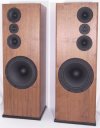benanders
Senior Member
Yes, I reckon slim is basically width vs height (but with an upper limit on width perhaps, at least for domestic room scale). It is limited by—but isn't mitigated by—driver diameter (for drivers on the front baffle). And depth doesn't matter much.
So that Infinity mid-treble module at post #108 isn't slim. But the bass module is. For sure if you are an engineer you might be taken by those driver ratio possibilities. My brain shut down immediately on reading those. That's also why nobody talks to engineers at parties (except for other engineers, of course).
For specifics, my speakers are 202 mm wide by 1195 mm tall (which I'll call 200 x 1200 because I'm not building them myself) which is a 1:6 ratio. I reckon 1:5 is still slim but 1:4 is pushing it. They are 370 mm deep but that's of no consequence wrt slimness. Like the KEF designs that followed Audio Physic's lead, the wider bass driver is mounted sideways. Mounting that on the front would lead to ~300 mm baffle, so 1:4 which I'd start to call athletic rather than slim.
For comparison, Focal Utopia series floor-standers are in the 1:3 range and definitely not slim.
Thanks for the thoughtful reply, @Axo1989 .
Whatever the ratio rule-of-thumb, there’s gotta be an interaction effect of speaker w:h x room w:h. No telling how that’d scale among individuals’ perceptions.
I think much of this thread is contrasting effects of driver SA / X-max (under the guise of a podcast topic I won’t put time into hearing

